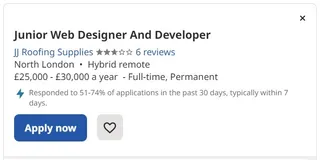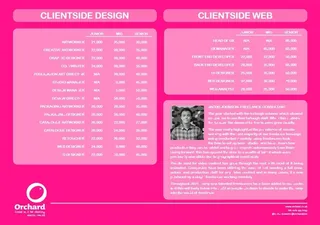Is Web Design a Good Career?


You’ve probably heard the adage that it takes 10,000 hours to master a skill. It sounds romantic when put this way, but if you think of how this equates to 416 days (yes, as in 416 days of 24-hour non-stop skill mastering), or alternatively three hours a day for nine years, it just sounds unrealistic and, quite frankly, exhausting.
Even if you don’t put 10,000 hours into levelling up on a skill, setting your heart on any career direction, any plan for professional growth, takes considerable time, effort, bravery, investment, and energy.
So, is a career in web design worth it?

Image source: pexels.com
It’s important to fully understand the role of a web designer before embarking on the challenging journey to becoming one. Getting a solid idea of what you can expect from the role means you won’t be disappointed, but you’ll also establish clear goals and ambitions, which will come across more easily when applying for jobs. This confidence can do the world of good during your interviews and will show you to be a mature and informed candidate.
Simply put, a web designer creates all the visual elements of a website. This includes the layout, colours, typography, imagery, and any other components that contribute to the visual aesthetic of a website.
Web designers don’t just concern themselves with making things look ‘good’. It’s also important for them to know how a user should navigate a website using visual cues. This ability to carve an intuitive pathway through the pages is essential to fulfilling the goal of a website. Because of this, most web designers will have some knowledge of or training in UI and UX design.
Primary responsibilities of web designers
Creating web page layouts
Creating rollover animations
Designing brand guidelines for websites
Designing page wireframes and mockups
Coming up with menu layouts and designs
Creating hierarchy on pages to guide the eye
Designing visual elements like buttons, graphics, banners, and content blocks
Things web designers don’t do (or only do occasionally)
Creating the sitemap
Writing content for web pages
Populating the website with content
Designing the company logo for the website
Creating marketing material for the company
Building pages using HTML, CSS, or JavaScript
Handling website hosting and buying a website domain
No two web design jobs are the same, and often roles see some blending so web designers might work on some other tasks. For example, a web designer may also create promotional material for launching a new website, such as social media images and ad creatives. Because of this, it’s important to get a clear understanding of the specific role when interviewing for a web design job.
Get information on the best website hosting companies and the best domain name providers in the UK in our blog.
Web design shouldn’t be confused with web development. These are very different careers. Where a web designer is concerned with the visual layout, style, and aesthetic of a website, a web developer is responsible for the actual creation of the functioning site. Here’s a comparison to give an idea of how these roles differ.
Web Design | Web Development |
Uses tools like Photoshop, Illustrator, and Figma. | Uses coding languages like HTML, PHP, Python, and JavaScript. |
Concerned with how a website looks and feels. | Concerned with how a website functions and behaves. |
Creatively driven. | Logically driven. |
Many people who are unfamiliar with the industry lump web design and web development together, but these are, in fact, entirely different jobs. If you see a company advertising a job like this:

They may be hoping they can get away with asking you to do two jobs in one, or they just don’t know what the role entails. Of course, there is variation in every job. There’s no set template for the job of a web designer, but web design and web development are highly differentiated types of work. This is one example of why you must take control of your career options by being clear and confident about what you can do as a web designer and what should be expected of you.
It’s difficult to know for sure if any career path is the correct one. Most people start out in one direction with their university degree or first job, only to completely change course over the first years of their professional life. This is totally normal, and taking risks is good when you feel your interest is pulled in a particular direction.
Being well informed is the best way to proceed. So, how do you know if web design is the right career for you? Determining if you suit the job of a web designer means combining your skills and talents with what you enjoy and what motivates you.
Hard skills are the qualifications and training that certify you as someone who can do web design. These are how you can demonstrate your capability to produce professional design work. Web designers generally need some of the following hard skills:
Figma
Adobe XD
Adobe Sketch
Adobe Illustrator
Adobe Photoshop
An understanding of HTML, CSS, and JavaScript
An understanding of the principles of UX and UI design
An understanding of CMS like Craft, WordPress, and Magento 2
An understanding of eCommerce platforms like Shopify, WooCommerce, and Craft Commerce
A good handle on these commonly used web design software is vital to being able to produce high-quality professional design work. Web designers aren’t expected to know how to write code or the intricacies of how an eCommerce website is made, but it helps to have familiarity with these tools to anticipate the functionality of a website and incorporate this as the design stage.
In terms of web design qualifications, a certificate or degree in a digital design-based medium is the most appropriate. As web design is such a creatively-led practice, a strong portfolio can speak volumes about your capabilities. In contrast, a grade on a piece of paper is much more difficult for a prospective employer to quantify.
While a design-related qualification helps, it’s not necessary all the time. Many web designers land jobs on portfolio work alone because they can demonstrate a good eye for design, growth potential, and attractive personality traits.
Soft skills are personal traits that demonstrate non-technical strengths that are less quantifiable than using a piece of software, for example. These could be personality traits or abilities that show how well you work in a team, how well you might work with specific people, or how easily you might adjust to a certain task.
Web designers need some of the following soft skills:
Creativity
Objectivity
Teamwork
Adaptability
Communication
Time management
Client management
It’s no surprise that any kind of designer has to be creatively driven and objective about their work. Being able to come up with visual solutions that convey the branding and personality of client’s brand is essential. It’s also a valuable skill if the designer can quickly adapt to new styles and review design work objectively (not just through their own preferences) to determine how effective it can be for the brand in question.
A good web designer must also communicate well with different team members, including web developers, account managers, and clients, to get the job done. Acquiring soft skills is more complex than hard skills. There’s no course with a certification at the end to tell people you’re good at managing your own time. This is something you should be able to demonstrate through previous work and achievements.
What’s the general consensus on web design as a career? What can junior web designers expect when they embark on their first job in the industry? Here’s what MadeByShape web designers Ella Dawson and Mike Ashurst had to say.
“Web design allows you to be a creative problem solver and then have the joy of seeing your work displayed to the world at the push of a button. Lots of web designers these days can work in the comfort of their own home or anywhere in the world due to being a digital career choice. You can work with people halfway across the world or someone down the road and it’d be no different”
“But it’s definitely a challenging job. Web Designers need to consider many aspects, from styling to user journey, to sitemaps, to SEO, and responsiveness. There are a lot of challenges to face and problems to solve when navigating a web design project that are crucial to a successful website.”
“Working as a web designer is a brilliant career for anyone with a creative mind, like myself: it allows me to use all my creativity to reach a common goal within our team. There are also lots of challenges, but the main one is to solve a client’s problem. They send a brief, and it’s my job to interpret what they want and put it into a user-friendly web design.”
Web design is a fast-moving career choice, and a good web designer must be able to effectively manage their time, prioritise, and work well under pressure. This is particularly true of working in a web design agency where you are expected to work on several projects at once and handle last-minute changes to project timelines or alterations to designs as part and parcel of the job.
It’s not only in the nature of the work that web designers need to be highly responsive. In such a highly competitive space, staying ahead of design trends, software developments, and industry practices is vital if you intend to stand out from the competition and offer higher value to your employer or clients. A good web designer must constantly react and adapt to keep up with the swift digital design world.
The internet continuously produces helpful content for self-training, skill growth, inspiration, and troubleshooting. There’s never been more free learning material available to help you reach your goals in web design. Websites like Behance allow designers to view a plethora of inspirational design material, and companies like Webflow offer a range of free courses for web design beginners or those looking to develop specific skills.
Social media platforms like the web_design forum on Reddit offer students, professionals, and amateurs a chance to connect, discuss industry topics, and ask questions. The mutually supportive digital environment is highly conducive to self-study, giving you the freedom to learn and grow at your pace in your chosen direction.
Web design is an artistically rich practice which demands a high level of creativity, problem-solving, and critical thinking. It’s an attractive career for those who need regular mental stimulation. There’s not likely to be much monotonous work or repetitive tasks.
This isn’t all fun, though. It requires a high degree of mental energy and a self-starter attitude. Many people can find this type of work exhausting, so this is yet another reason to consider whether it’s something you truly enjoy.
In a continually growing digital world, web design is a wise career direction. In March 2022, IBISWorld forecasted the web design industry to grow at a rate of 1.3% per year over the next five years to reach a value of £575.1 million. By taking steps towards a career in web design, you can ensure you develop skills and experience in an industry set to flourish.
Experience in web design can also open doors to other careers through transferable skills, referrals, and inside experience. Many people who start a career in web design move on to more specialist roles such as UI design and app design, or even change course completely as they learn more about their skills and what interests them.

Image source: orchard.co.uk
To assume anyone wants to pursue a career in web design purely for enjoyment would be dishonest. In the 2022 Orchard Salary Survey, 83% of respondents said pay was one of the most popular aspects of a prospective new job. Salary is one of the primary motivators whenever you’re searching for a job, so it’s helpful to know what sort of salary you can expect from web design.
Not only this, but having a solid idea of the salary range you are entitled to enables you to negotiate during your interview more effectively.
The Orchard survey reported the average salaries of web designers in 2022 to be the following:
Junior: £42k
Midweight: £30k
Senior: £40k
The average salary of a web designer wasn’t as high as some other fields of design work, including UX design (midweight: £35k), but proved to be higher than quite a few other specialisms such as graphic design (midweight: £28k), packaging design (midweight: £28k), and artworker (£25k).
So, now you know how much a web designer's salary is when working in-house or with a web design agency, but what about freelance and contractor opportunities? Things become a little more complicated here. It all depends on how much work you can secure and the rates you offer, which are factored into the overall cost of a website for your clients. Depending on skill level and individual project requirements, freelance web designers can make anywhere between £10 and £100 per hour.
There are over 2,000 web design agencies in the UK, so what’s the competition like if you want to get your foot in the door?
Web design is in high demand at the moment, and, as per IBISWorld’s forecast, it is only set to grow. A survey by 20i on web designers found that 54% of responders work full time, and 15% work over 49 hours per week. These hours were reported to be dedicated to web design only, not other miscellaneous tasks like admin and client communication. 60% of respondents said they are as confident in their job security as they were 12 months ago.
These statistics are even more promising in a post-pandemic world where so many have been made redundant, businesses have been closed, and the working world at large has seen seismic shifts.
44% of respondents to the 20i survey said they carry out freelance work of some kind. With the current climate of entrepreneurship and self-improvement (not to mention open access to learning resources discussed earlier), the landscape for starting your own web design agency looks advantageous, too.
Here’s a summary of the landscape of a web design career.
Aspect | Expectation |
Salary | Upper-mid level compared with other design specialisms. |
Competition | Highly competitive but in a growing industry. |
Requirements | Strong portfolio, creativity, communication skills, and time management. A self-starter. Official qualifications are not necessarily needed. |
Pros | Creatively stimulating, not monotonous, opportunities for continued development. |
Cons | Mentally demanding, fast-paced nature of work can be taxing. |
If you’ve decided this is your career path, the best place to start is with your portfolio. This is the single most valuable item in your arsenal for competing against the thousands of others in your position.
Many design courses will prepare you so that you have a working portfolio on graduation, but be sure you do lots of detailed research into how to bring the most value to your portfolio. Ensure a wide range of projects to choose from, as you will benefit from tailoring your portfolio to each job you apply for. This is important to ensure your application is as relevant to the position as possible.
When considering the job type you want, consider whether you’re after the dynamic agency environment or a more slow-paced in-house position. Large and small creative agencies offer better opportunities for web designers at the start of their careers, and you’ll have plenty of exposure to different industries, project types, and challenges.
There’s no right or wrong way to take this journey, though. Use your initiative to travel a career path that is truly rewarding to you.
Hello, I'm Natasia, and I'm a content writer for Shape.